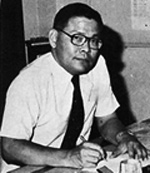|
In 1950, Post School Certificate Classes, later known as Pre-University classes, were set up and the first batch of female students were enrolled in ACS. Two years later, Mr Thio Chan Bee, an Old Boy, became the School’s first Asian Principal.
On January 7th 1955, ACS became the first Methodist school to have a Board of Governors. With the formation of the BOG, the Old Boys were able to provide even better service to the school as the Board, as it still does, comprises representatives from the Methodist Church, the ACS OBA and the ACS family.
The attainment of self-government and political independence of the 1950s and ‘60s were a powerful force which raised educational horizons and made desirable significant new facilities.
The first of the famous ACS Fun-O-Ramas was held on the Barker Road campus in 1956 to raise funds for the Pre-University block (‘Lee Hall’) which was fully equipped with science laboratories and a library.
Another breakthrough was the design and building of the Sports Complex and gymnasium and the first Olympic-sized school swimming pool in Singapore.
In the half century since the 1970s, educational expansion and upgrading saw even more dynamic changes to the School. ACS embraced the trend of introducing Junior College education and it established our Anglo-Chinese Junior College in 1977. ACJC also had the first full-sized football field and 400m running track that an ACS unit ever enjoyed.
The 1980s were yet another memorable period, with the building and resuscitation of Oldham Hall in 1985 to house both foreign scholars and ACS students. In addition, the Junior School moved out to a refurbished school building at Peck Hay Road with more space and facilities. On a grander scale was the transformation of Anglo-Chinese Secondary School to ACS (Independent) in 1988.
ACS (Independent) was first located at Barker Road. In January 1992, the school made its move to its new campus at Dover Road. The site was officially opened by Dr Richard Hu, Minister of Finance of Singapore, on March 1st 1993. ACS (Independent) was recognised as an IB World School in 2005 and was the first national school in Singapore to offer the International Baccalaureate Diploma.
Two years later in January 1994, ACS (Barker Road) was established as a full government-aided secondary school. The purpose of ACS (Barker Road) was to provide the feeder pupils from the two ACS primary schools with an additional option to continue with an ACS secondary education.
ACS ended the 20th century with a massive construction programme- this time, the complete rebuilding of the Barker Road campus to provide the new Barker Road Secondary and Primary School with an associated auditorium and performance theatres that set new standards in school architecture, appropriately winning a prestigious award for innovation and excellence. The completely new Oldham Hall stands as yet another feather in the cap of ACS.
As the dawn of the 21st century, the ACS
Family welcomed its sixth member - ACS
(International) which opened its doors
on January 3rd, 2005 to a multinational
cohort of students. To reinforce the
unity of the ACS Family, the ONE ACS
initiative was launched in 2006 to
re-evaluate the mission and core values
of our rapidly growing family.
In 2007,
STB-ACS (International) Jakarta became
the first Anglo-Chinese School outside
Singapore. The newer members to the ACS
family promise to be further innovations
in the history of “Our ACS Forever”.
To
accommodate the further growth of our
student population, Anglo-Chinese School
(Junior) moved to its current premised
at Winstedt Road in December 2008.
The
ACS family looks to the future of our
school with great anticipation for
another 125 glorious years and many more.
 *
Affectionately known
as the Mr. Chips of ACS,
Mr Earnest Lau had
influenced the lives of
thousands of ACS
students. Many older
ACSians associate him
with the stirring and
nostalgic “40 Years On”
which he taught and sang
with gusto when he first
joined ACS as a teacher
in the mid-fifties,
whilst others from the
1977 to 1983 era
remember his charismatic
leadership when he was
Principal. An author of
several books and an
authority on ACS
history, Mr Lau was the
Archivist of The
Methodist Church in
Singapore before he
passed away on 05 March
2011. *
Affectionately known
as the Mr. Chips of ACS,
Mr Earnest Lau had
influenced the lives of
thousands of ACS
students. Many older
ACSians associate him
with the stirring and
nostalgic “40 Years On”
which he taught and sang
with gusto when he first
joined ACS as a teacher
in the mid-fifties,
whilst others from the
1977 to 1983 era
remember his charismatic
leadership when he was
Principal. An author of
several books and an
authority on ACS
history, Mr Lau was the
Archivist of The
Methodist Church in
Singapore before he
passed away on 05 March
2011. |
|